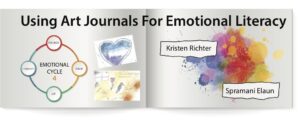We’ve talked before about reframing negative or stressful situations into something positive, and we’ve even gone into detail about developing a growth mindset, which involves seeing challenges as opportunities to grow. Those are both emotional literacy tactics that can be incredibly helpful to students, and they both take practice.

The more tools, resources, and new perspective we can give our students, the more emotionally literate we’re helping them become. If we teach them these reframing methods now, we’ll lay the foundation for setting them up for success as adults. (And this has a ton of positive ramifications that ripple out into their families, friend circles, and greater community.)
This week, we want to dive deeper into the idea of finding the silver lining in stressful situations.
What is the ‘Silver Lining’?
You’ve probably heard the phrase or proverb, “Every cloud has a silver lining,” but maybe you’ve never given it a second thought. The silver lining is a sign of hope or a positive aspect in an otherwise negative situation. When you look for the silver lining, you’re emphasizing the hopeful, positive side of a situation that might seem negative on its surface.
How to Find the Silver Lining
It’s easy to tell people to ‘find the silver lining,’ but when it comes down to it, sometimes the negative situation can feel too overwhelming to do so. It’s another reframing technique that takes practice.
Remember to have these conversations when everyone is regulated and feeling good! Begin by having them take small steps and focus on their resources and take gradual steps to shifting their perspective. They are getting out of the negative part of their mind and into a more positive space. Ask:
- What are some good things that you have right now, or are happening to you right now?
- What resources, (or things) do you have that you can use to help make positive a change?
Once you can get students to focus on the resources they have and can use, they’ll be able to shift their mindset into an even more positive space and get better at finding the silver lining.

What’s the silver lining? What are the good things?
For example, when the pandemic hit and schools closed, it became a huge challenge for students and teachers to deal with. We’re no longer interacting face to face, and while technology is helpful, it’s not the same. Now, we could choose to be upset about this and only focus on the negative, but it’s the perfect situation to find the silver lining. Students might say, “I get to spend more time with my family,” “I get to play with my dog during the day,” and “I get to sleep in and wear my pajamas to class.” As a teacher, maybe your silver lining is more along the lines of, “I get to be creative with the lessons I present,” “I don’t have a commute anymore,” and “I have more time with my family too.
One Quick Implementation Strategy: Identify Strengths
When we identify our strengths in combating stress, we really focus on the positive. This may bring in the growth mindset reframing method, which can then lead into finding the silver lining. For example, you’re feeling overwhelmed with work or projects, you could focus on a strength, “I’m very organized,” then the silver lining, “I can channel this overwhelm into creating a system that helps me get everything done.”
By Spramani Elaun & Kristen Richter
© 2020 All Rights Reserved


